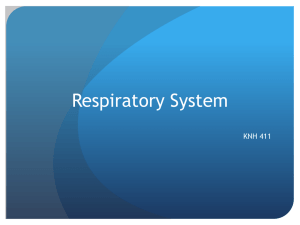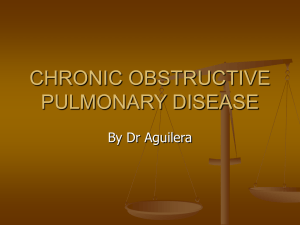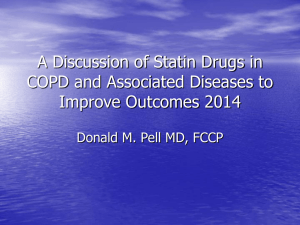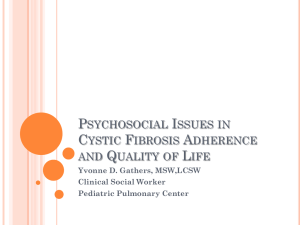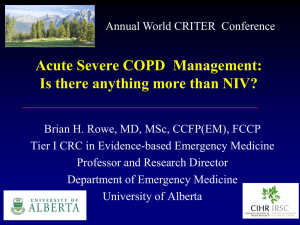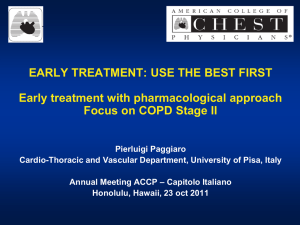Vanessa Clark RD, LD - South Carolina Society for Respiratory Care
advertisement
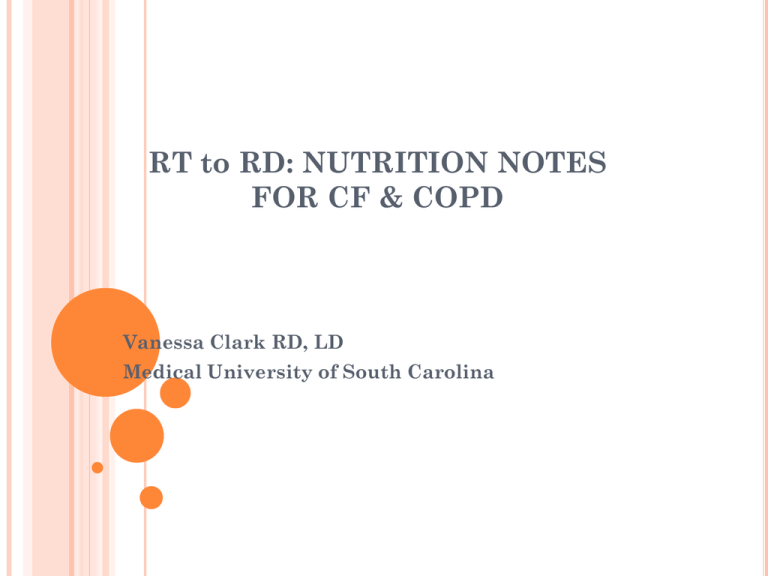
RT to RD: NUTRITION NOTES FOR CF & COPD Vanessa Clark RD, LD Medical University of South Carolina DISCLOSURES I work primarily with cystic fibrosis patients Food and nutrient-specific research is difficult and multi-layered Cross-sectional analysis vs RCT Foods vs nutrients Diet recalls vs Food frequency vs Serum levels Reporting accuracy Sometimes I eat cake A NUMBERS GAME Chronic Obstructive Pulmonary Disease: WHO predicts that by 2020 COPD will be the 3rd leading cause of death worldwide and will rank 5th for disease burden and chronic disability worldwide Is among the 3rd leading cause of death in the US Cystic Fibrosis: Affects 70,000 people worldwide Median survival is in the late 30s (CF Foundation) Methods of Measurement Weight = those numbers you see on a scale BMI = weight / height <18.5 = underweight 18.5-25 = normal >25 = overweight >30 = obese FFM = Fat Free Mass Water (~73%) Protein Minerals Muscle COPD: HOW NECESSARY IS NUTRITION? Body weight and FFM affect exercise tolerance and response, gas trapping, and diffusing capacity Reduction in FFM is related to… Reduction in peak O2 consumption Reduction in peak work rate Reduction in respiratory muscle mass & strength Earlier lactic acid production Muscle fiber atrophy, particularly type II COPD: HOW NECESSARY IS NUTRITION? 25-40% of COPD patients experience weight loss 25% of patients with moderate-severe disease have reduced FFM 35% of patients with very severe disease have reduced FFM 45% of COPD pts eligible for pulm rehab are underweight or have depletion of FFM Malnutrition in 30-60% of inpatients and 10 to 45% of outpatients (BMI <20 or <90% IBW) COPD: HOW NECESSARY IS NUTRITION? Decreased QOL weight = decreased lifespan and 2-4 year estimated survival time in patients with severe disease who are lean and have an FEV1% of <50% BMI <20 is associated with higher exacerbation risk Skeletal muscle weakness is related to… Worsened health status Increased healthcare costs Increased mortality risk EXERCISE CAPACITY IN COPD PATIENTS POST-LUNG TRANSPLANT Williams, T. J., Patterson, G. A., McClean, P. A., Zamel, N. and Maurer, J. R. (1992) Maximal exercise testing in single and double lung transplant recipients. Am. Rev. Respir.Dis. 145, 101–105 LIMITATIONS TO BIKING EXERCISE AMONG COPD PATIENTS Man, W. D., Soliman, M. G., Gearing, J., Radford, S. G., Rafferty, G. F., Gray, B. J., Polkey, M. I. and Moxham, J. (2003) Symptoms and quadriceps fatigability after walking and cycling in chronic obstructive pulmonary CF: HOW NECESSARY IS NUTRITION? BMI is strongly associated with lung function: Malnourished patients have lower average vital capacity, arterial oxygen partial pressure, and FEV1 Malnutrition among adolescents 12-18 years was associated with an FEV1 drop of ~20%; FEV1 was maintained at >80% in normal weight patients Patients with FFM depletion have reduction in FEV1 and bone density even if BMI value is maintained Goals: >50th %ile weight/length for children 0-2y >50th%ile BMI for children 2-20y BMI >23 for male adults BMI >22 for female adults * Cystic Fibrosis Foundation * Cystic Fibrosis Foundation APPETITE AND INTAKE Reduction due to: in appetite and intake is common Changes in breathing induced by eating (chewing and swallowing) Decreased oxygen saturation during meals Increased post-prandial dyspnea Mucus accumulation GI distress and coughing induced emesis Hormonal irregularities: leptin Anorexia of chronic disease Anxiety, depression, psychosocial factors CALORIES AND PROTEIN Increased energy expenditure caused Increased WOB Chronic infections Medical treatments and therapies CF: ~120-200% increase in caloric needs ~150%-200% increase in protein needs Malabsorption, increased REE, increased by: WOB COPD: ~95-150% of predicted caloric needs ~150-200% increase in protein needs REE elevation due to: medications, inflammation, activity, inefficient ventilation MIXING MACRONUTRIENTS Balanced nutrient and meal profiles: Carbohydrates 40-55% of calories Fat 30-45% of calories Protein 15-20% of calories MACRONUTRIENTS: CARBOHYDRATES RQ of 1 Excessive CO2 production seen with carbohydrate administration has been isolated to cases of energy excess MACRONUTRIENTS: FATS Higher caloric load: 9kcal/g Increased gastric emptying time Malabsorption in CF MACRONUTRIENTS: PROTEIN No storage form of protein in the body Stable: 1.5g/kg body weight Acute: 1.5-2g/kg body weight Protein repletion and muscle preservation is difficult during acute exacerbations Body prioritizes making other proteins Prealbumin and albumin are poor indicators of nutritional status in an acute setting Optimize protein status as outpatient Protein Sources: milk, yogurt, meat, fish, shellfish, tofu, poultry, beans, nuts SNEAK A SNACK: POST-WORKOUT NUTRITION Both weight and FFM improve with daily nutritional snack provision as a part of a pulmonary rehab program Better weight gain than with nutrition intervention alone Improvement in respiratory muscle strength, exercise capacity, health status, and survival rates Strength training in conjunction with nutrition support was an important component of this data Recommend a Bonus points protein/carb combo for fruit or veg HIGH CALORIE FOOD ADDITIVES Mayonnaise Whole milk Whole yogurt Nuts & Nut butters Full fat dressing Ground nuts Avocado Sour cream Whole milk powder Oils Coconut, palm for CF Peanut, olive, safflower, sunflower, canola, etc for COPD Butter Cheese Heavy cream Chocolate Whipped Cream ORAL SUPPLEMENTS “In addition” vs “instead of” Supplements and COPD: Increases daily caloric intake by ~200400kcal/day Produced a weight gain of ~1.8kg (3% body wt) Increased grip strength by ~5% Supplements and CF: Limited efficacy Better results with enteral nutrition ORAL SUPPLEMENTS High calorie supplement examples Boost Plus Ensure Plus Scandishake Opt2Thrive NutraBalance Homemade Shakes Peanut Butter & Banana Peanut Butter & Chocolate Frozen Berries with Yogurt & Milk Nutella Greek yogurt, regular yogurt, kefir, ice cream, milk Protein powder INFLAMMATION Pulmonary dysfunction as an imbalance between oxidation production and antioxidant function Alveolar wall destruction Loss of elastic recoil Pro-inflammatory cytokines are associated with muscle wasting Free radicals cause cellular damage through oxidation Increases inflammation Antioxidants: eliminate oxidants or prevent creation of more toxic compounds Reduces inflammation YOUR MOM WAS RIGHT Eat Increase in fruit and vegetable consumption reduces risk for COPD your fruits and vegetables! Possible risk reduction of 24% Cross-sectional study following patients for 5-7 years found an association between increased fruit and vegetable intake and a higher FEV1 Decrease in consumption was associated with a decrease in FEV1 EDIBLE ANTIOXIDANTS Omega-3 Fatty Acids (EPA & DHA) Vitamin A (beta-carotene) Vitamin C (ascorbic acid) Vitamin E (alpha-tocopherol) Selenium Flavonoids Ubiquinone (CoQ10) PREVENTING CATABOLISM: INHIBITING INFLAMMATION Omega-3 polyunsaturated fats (PUFA) Eicosapentaenoic acid (EPA) Docosahexaenoic acid (DHA) Food Sources: Oily fish (salmon, mackerel, tuna, sardines, herring, bluefish, trout, catfish), shrimp, monounsaturated oils (canola, flaxseed, olive oil) PREVENTING CATABOLISM: INHIBITING INFLAMMATION Omega-3s: Anti-inflammatory Replaces pro-inflammatory fatty acids in actively inflammatory cells May decrease production of pro-inflammatory mediator cells and TNF- and interleukin-1 Increased peak exercise capacity & submaximal endurance time seen with adequate intake Caution with supplementation PREVENTING CATABOLISM: INHIBITING INFLAMMATION Omega-6s: Linoleic Acid --> Arachidonic acid Present in higher quantities in inflammatory cells Pro-inflammatory compound Western diets have seen an increase in the omega6/omega-3 ratio Optimal ratio = 2:1 to 3:1 Current intake is ~4 times this Food Sources: polyunsaturated oils (soybean, corn, safflower, sunflower), poultry, eggs, coconut, margarine AMAZING ANTIOXIDANTS: VITAMIN A Lipid soluble Stored in body’s fat cells Best absorbed with a source of fat Inactivates free radicals and superoxide anions Food Sources: liver, fortified milk, egg, carrots, spinach, kale, cantaloupe, apricots, papaya, mango, oatmeal, peas, peaches, red pepper, sweet potato, pumpkin AMAZING ANTIOXIDANTS: VITAMIN E Lipid soluble Stored in fat, absorbed with fat Works by stopping reactions that cause lipid peroxidation FEV1 better maintained in subjects with higher vitamin E intake Food Sources: fortified cereal, sunflower seeds, almonds, sunflower oil, hazelnuts, pine nuts, peanuts, peanut butter, peanut oil, safflower oil, olive oil, corn oil, canola oil, turnip greens, spinach, avocado AMAZING ANTIOXIDANTS : VITAMIN C Water Soluble Excreted when consumed in amounts that exceed the body’s requirement Little risk for toxicity Abundant in the extracellular fluid surrounding the lungs Beta-carotene scavenges free radicals and inhibits inflammatory metabolites Functions in the immune system Found in neutrophils and lymphocytes AMAZING ANTIOXIDANTS: VITAMIN C FEV1 better maintained in subjects with higher vitamin C intake Food Sources: red pepper, kiwi, orange, grapefruit, strawberries, brussels sprouts, cantaloupe, papaya, broccoli, sweet potato, pineapple, kale, mango, tomato juice BONUS BENEFITS Flavonoids: fruits & vegetables Ubiquinone (CoQ10): meat, fish, poultry, nuts, oils Selenium: tuna, beef, cod, turkey, chicken, enriched noodles, egg, bread, oatmeal, rice, cottage cheese, walnuts Magnesium: cereals, nuts, green vegetables, dairy products VITAMIN D: BETTER THAN BONES Increased risk for vitamin D deficiency among patients with chronic obstructive lung disease More than just a bone builder: Anti-inflammatory properties Immune function Ameliorate symptoms of depression VDR in kidneys, intestines, bones, pancreas, gonads, liver, heart, brain, breast, hematopoietic, and immune systems COPD: Deficiency in 57-93% of inpatients and 60% of patients with severe disease Large, cross-sectional NHANES study showed an FEV1 improvement of 126mL with highest level of vitamin D intake CF: Decrease in serum vitamin D level correlated significantly with decrease in lung function VITAMIN D Lipid soluble Best absorbed with a source of fat Food sources: herring, salmon, halibut, catfish, mackerel, oysters, shitake mushrooms, sardines, tuna, shrimp, egg, fortified foods (juices, milks, pudding, cereal, etc.) Sunlight! Supplements! D3 ANABOLIC AGENTS: GLUTAMINE, CARNITINE, CREATINE Glutamine: Branched-chain amino acid Possible increse in whole body protein synthesis, increase in body weight and FFM, decrease in blood lactic acid, increase in arterial blood oxygen partial pressure Creatine: Abundant in meat and fish Studies have been unable to show an improvement in muscle strength, exercise tolerance, or HRQoL with creatine supplementation ANABOLIC AGENTS: GLUTAMINE, CARNITINE, CREATINE L-Carnitine: Amino acid derivative Increases energy production by promoting lipid breakdown RCT demonstrated an increase in inspiratory muscle strength and walk test tolerance; decrease in blood lactate levels Needs more testing FOOD FOR THOUGHT REFERENCES Collins PF, Stratton RJ, Elia M. Nutritional support in chronic obstructive pulmonary disease: a systematic review and meta-analysis. Am J Clin Nutr. 2012; 95: 1385-1395. Cystic Fibrosis Foundation. cff.org. September 2013. Gilbert CR, Arum SM, Smith CM. Vitamin D deficiency and chronic lung disease. Can Respir J. 2009; 16(3): 75-80. Engelen MPKJ, Schroder R, van der Hoorn K, Deutz NEP, Com G. Use of body mass index percentiles to identify fat-free mass depletion in children with cystic fibrosis. Clinical Nutrition. 2012; 10. Itoh M, Tsuji T, Nemoto K, Nakamura H, Aoshiba K. Undernutrition in patients with COPD and its treatment. Nutrients. 2013; 5: 1316-1335. Mahan LK, Escott-Stump S. Krause’s food and nutrition therapy. Saunders Elsevier. 2008: St. Louis, MO. Man WDC, Kemp P, Moxham J, Polkey MI. Skeletal muscle dysfunction in COPD: clinical and laboratory observations. Clin Sci. 2009; 117: 251-264. Schols, A. Nutritional modulation as part of the integrated management of chronic obstructive pulmonary disease. Proceedings Nutr Society. 2003; 62: 783-791. Steinkamp G, Wiedemann B. Relationship between nutritional status and lung function in cystic fibrosis: cross sectional and longitudinal analyses from the German CF quality assurance (CFQA) project. Thorax. 2002; 57: 596-601. Romieu I, Trenga C. Diet and obstructive lung disease. Epidemiol Rev. 2001; 23: 268-287. Woestenenk JW, Castelijns SJAM, van der Ent CK, Houwen RHJ. Nutritional intervention in patients with Cystic Fibrosis: A systematic review. J Cyst Fibros. 2013; 12: 102-115. QUESTIONS?
